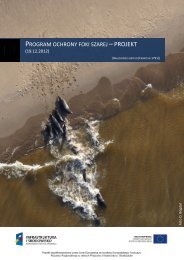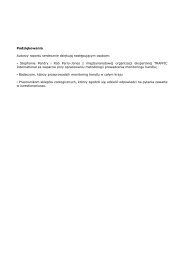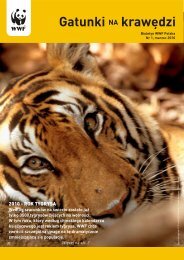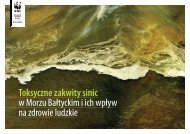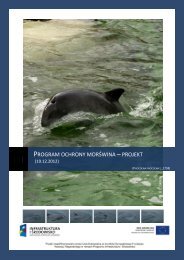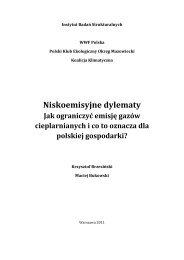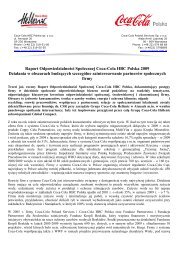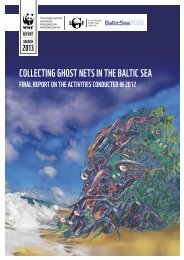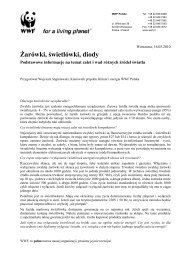Water scarcity depends on the amount of water available <strong>and</strong> levelsof consumption in a river basin, not only the absolute size of theBlue Water Footprint. For example, even though the Blue WaterFootprint is not particularly large in eastern European <strong>and</strong> Asianriver basins in February or March, these basins (including theDniepr, Don, Volga, Ural, Ob, Balkhash <strong>and</strong> Amur) experience highwater scarcity in these months as the river flows are low during thisperiod (Figure 43).Industrial <strong>and</strong> domestic water supply is impacted if waterflows cannot be maintained. In the Yellow <strong>and</strong> Tarim river basinsin China, the most severe water scarcity is in early spring, whenrun-off is low <strong>and</strong> water dem<strong>and</strong> for irrigation is high. SouthAfrica’s Orange <strong>and</strong> Limpopo river basins experience water scarcityin September <strong>and</strong> October, <strong>and</strong> the Mississippi River basin in theUS in August <strong>and</strong> September, when the Blue Water Footprint ishighest <strong>and</strong> run-off is lowest (Hoekstra et al., 2012). A careful waterallocation mechanism that takes into account current <strong>and</strong> predictedfuture water uses <strong>and</strong> environmental requirements on monthlybasis, not on the basis of annual averages, is therefore necessary.FebruaryFigure 43: Water scarcityin the world’s majorriver basins in February<strong>and</strong> JuneLight blue shading indicateslow water scarcity, meaningthat presumed environmentalflow requirements are notcompromised <strong>and</strong> monthlyrun-off is unmodified or onlyslightly modified; bright blueshading indicates moderatewater scarcity (i.e., theBlue Water Footprint is20-30% of natural run-off)<strong>and</strong> environmental flowrequirements are not fullymet; dark blue shadingindicates significant waterscarcity (i.e., the Blue WaterFootprint is 30-40% of naturalrun-off); purple shadingindicates severe water scarcity(i.e., the Blue Water Footprintexceeds 40% of naturalrun-off). The differences inwater scarcity in the twomonths for many river basinshighlights the importanceof underst<strong>and</strong>ing waterscarcity at monthly time scales(Hoekstra et al., 2012).KeyNatural run-offMore than 40%30 - 40%20 - 30%0 - 20%Blue WaterFootprintRecently, for the first time, the Water Footprint Network has beenable to estimate the Blue Water Footprint at a high spatial resolution(at 5 by 5 arc minutes, which is a grid of about 9km by 9km at theequator <strong>and</strong> decreasing gradually toward the poles), on a monthlybasis. This detail of data on water availability throughout the year atriver basin level provides water planners <strong>and</strong> users with an importantplanning tool to ensure they make the most of this vital renewableresource. One example is given here <strong>and</strong> more can be found inHoekstra et al., 2012.Tigris-Euphrates BasinThe Tigris-Euphrates River Basin extends over four countries:Turkey, Syria, Iraq <strong>and</strong> Iran. Almost all of the run-off in the tworivers is generated in the highl<strong>and</strong>s of the northern <strong>and</strong> easternparts of the basin in Turkey, Iraq <strong>and</strong> Iran. Precipitation in thebasin is largely confined to the winter months of October to April,with high waters occurring from March to May – as snow melts inthe highl<strong>and</strong>s. The typical low water season occurs from June toDecember. The basin faces severe water scarcity for five months ofthe year (June to October). Most of the Blue Water Footprint (52 percent) is due to evaporation of irrigation water in agriculture, mostlyfor wheat, barley <strong>and</strong> cotton.Million m 3 per month1200010000800060004000JuneBlue water scarcity2000> 21.5 - 21 - 1.50.5 - 10.25 - 0.50 - 0.25no dataSeverity ofBlue waterscarcity0Jan Feb Mar Apr May Jun Jul Aug Sep Oct Nov DecMonthFigure 44: Water scarcity over the year for the Tigris-Euphrates Basin(monthly average for the period 1996-2005) The river run-off is dividedinto four zones – green, bright blue, dark blue <strong>and</strong> white – based on presumptiveenvironmental flow requirements. The actual Blue Water Footprint is plotted overthis hydrograph as a solid thick red line. If the line falls in the green zone, the waterscarcity is low, meaning that there is no abstraction from the environmental quota.However, if it moves up into the bright blue, dark blue or white zones, water scarcitybecomes moderate, significant or severe in that part of the year.WWF Living Planet Report 2012 page 66 Chapter 1: The state of the planet page 67
Chapter 2: Why weshould care~A satellite image features the heart-shaped northern tip of thewestern half of the Large Aral Sea (or South Aral Sea) in CentralAsia. Once the world’s fourth-largest inl<strong>and</strong> body of water, the AralSea has been steadily shrinking over the past 50 years since therivers that fed it were diverted for irrigation. In 2005, a dam wasbuilt between the sea’s northern <strong>and</strong> southern sections to helpimprove water resource management <strong>and</strong> reverse the man‐madeenvironmental disaster. The dam allowed the river to feed thenorthern Aral, which has begun to recover. It hasn’t solved theentire problem though, as the southern section is expected to dryout completely by 2020. The whitish area surrounding the lakebedis a vast salt plain, now called the Aralkum Desert, left behind bythe evaporating sea. It comprises some 40,000 sq km zone of dry,white salt <strong>and</strong> mineral terrain. Each year violent s<strong>and</strong>storms pick upat least 150,000 tonnes of salt <strong>and</strong> s<strong>and</strong> from Aralkum <strong>and</strong> transportthem across hundreds of kilometres, causing severe health problemsfor the local population <strong>and</strong> making regional winters colder <strong>and</strong>summers hotter.design note:Check for gutter <strong>and</strong> repeatimage if necessary© USGS



